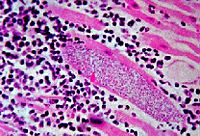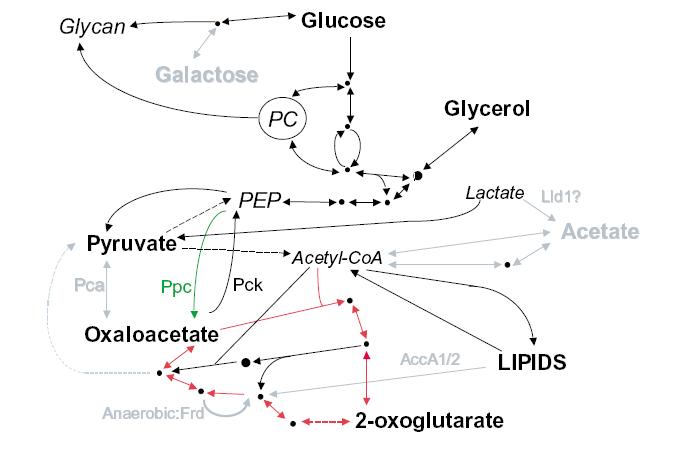Host Dependency of Mycobacterium leprae: Difference between revisions
| Line 15: | Line 15: | ||
define pseduogene, inablility to grow in media even with all of the added things | define pseduogene, inablility to grow in media even with all of the added things | ||
Mycobacterium leprae genome was sequenced by S. T. Cole and was published in Nature in 2001 []. His group found that the genome consisted of a single circular chromosome approximately 3,268,203 bp. The G-C content of the genome is 57.7%, and only 49.5% of the genome still codes for proteins []. The genomes for M leprae and M. tuberculosis are quite similar, and about 27% of M laprae's genome are pseudogenes that directly correspond to genes still expressed in M. tuberculosis []. The remaining 23% of the genome does not resemble coding genes; these sections seem to have mutated over time and are currently unrecognizable. The similarity of the pseudogenes in M leprae compared to expressed genes in M. tuberculosis suggest that the genome of M laprae has evolved to lose these genes because they were not necessary for survival. This is an example of reductive evolution. It is estimated that M laprae has lost approximately 2000 genes from its genome []. The loss of genes in metabolic pathways such as energy metabolism and limiting the carbon sources M laprae can use help to explain why M laprae can not be cultured in a laboratory and has only been shown to infect humans, the footpads of mice, and armadillos. | |||
<br> | <br> | ||
Revision as of 19:47, 15 April 2009
Introduction
Mycobacterium leprae, the bacterial cause of leprosy, is almost impossible to culture in a laboratory. M. leprae can only grow when acting as a parasite in animals with lower body temperature, such as armadillos, genetically immune deficient mice, or the extremities of a human body (Slonczewski). M. leprae has one of the slowest doubling times of any pathogen; it takes approximately 14 days for the cells to divide (Slonczewski). COMMENT ABOUT HOW CLOSE IT IS TO M TUBERCULOSIS
The genome for M. leprae has been sequenced, and it has been found that almost half of the genes are pseudogenes; genes that no longer code for proteins to be transcribed in the cell. Many of these pseudogenes correspond to genes found in Mycobacterium tuberculosis that are functional (Slonczewski). M. leprae seems to be evolving to lose
where can it grow
Mycobacterium leprae genome; missing genes in M. leprae compared to M. tuberculosis
1.Talk about the genome. 2. Discuss differences between M tuberculosis and M leprae use the two figures define pseduogene, inablility to grow in media even with all of the added things
Mycobacterium leprae genome was sequenced by S. T. Cole and was published in Nature in 2001 []. His group found that the genome consisted of a single circular chromosome approximately 3,268,203 bp. The G-C content of the genome is 57.7%, and only 49.5% of the genome still codes for proteins []. The genomes for M leprae and M. tuberculosis are quite similar, and about 27% of M laprae's genome are pseudogenes that directly correspond to genes still expressed in M. tuberculosis []. The remaining 23% of the genome does not resemble coding genes; these sections seem to have mutated over time and are currently unrecognizable. The similarity of the pseudogenes in M leprae compared to expressed genes in M. tuberculosis suggest that the genome of M laprae has evolved to lose these genes because they were not necessary for survival. This is an example of reductive evolution. It is estimated that M laprae has lost approximately 2000 genes from its genome []. The loss of genes in metabolic pathways such as energy metabolism and limiting the carbon sources M laprae can use help to explain why M laprae can not be cultured in a laboratory and has only been shown to infect humans, the footpads of mice, and armadillos.
Interaction and affect on host cells
Interaction still not well known, epithelial cells paper, operon 1 paper, lipids suppress t-cell activation paper
Include some current research in each topic, with at least one figure showing data.
Genetic component of the host
discuss different types of infections, some people more succeptable then others, use the three papers.
Include some current research in each topic, with at least one figure showing data.
Conclusion
Discuss how outbrakes are still a problem worldwide, what drugs we use to combat them, link to the lepra website.
References
[1] Slonczewski, J., Foster, J. Microbiology: An Evolving Science. New York: W. W. Norton, 2009. 700-702.
[] Ooi, W., Srinivasan, J. Leprosy and the Peripheral Nervous System: Basic and Clinical Aspects. Muscle and Nerve, October 2004. 393-409.
[] Schurr, E., Alcais, A., Singh M., Mehra, N., Abel, L. Mycobacterial infections: PARK2 and PACRG associations in Leprosy. Tissue Antigens, 2007. 231-233.
[] Geluk, A., Ottenhoff, T. HLA and Leprosy in the Pre and Postgenomic Eras. Human Immunology, 67. 2006. 439-445.
[] Wheeler, P. Leprosy- Clues about the Biochemistry of Mycobacterium leprae and its Host-Dependency from the Genome. World Journal of Microbiology and Biochemistry, 19. 2003. 1-16.
[] Ascenzi, P., Bolognesi, M., Visca, P. NO Dissociation Represents the Rate Limiting step for O2-Mediated Oxidation of Ferrous Nitrosylated Mycobacterium leprae truncated hemoglobin O. BBRC, 357. 2007. 809-814.
Edited by student of Joan Slonczewski for BIOL 238 Microbiology, 2009, Kenyon College.


